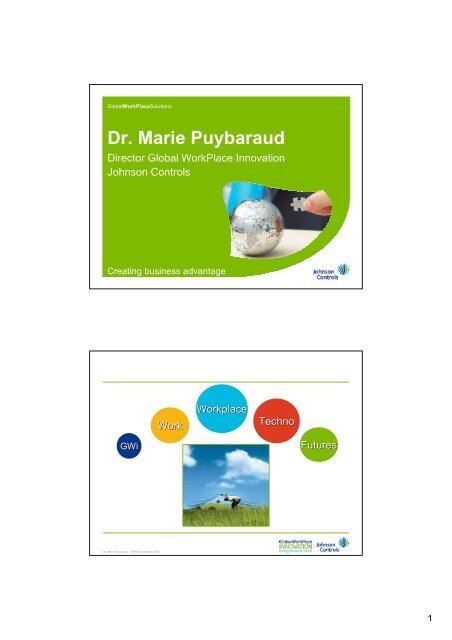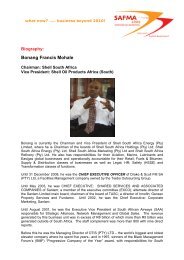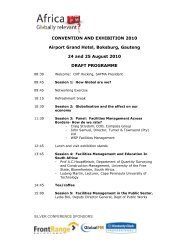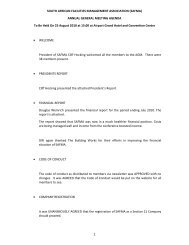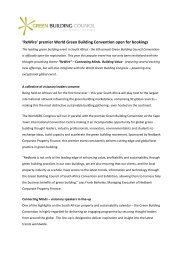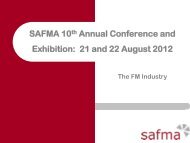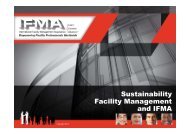Dr. Marie Puybaraud - safma
Dr. Marie Puybaraud - safma
Dr. Marie Puybaraud - safma
Create successful ePaper yourself
Turn your PDF publications into a flip-book with our unique Google optimized e-Paper software.
GlobalWorkPlaceSolutions<br />
<strong>Dr</strong>. <strong>Marie</strong> <strong>Puybaraud</strong><br />
Director Global WorkPlace Innovation<br />
Johnson Controls<br />
Creating business advantage<br />
Work<br />
Workplace<br />
Techno<br />
GWi<br />
Futures<br />
<strong>Dr</strong>. <strong>Marie</strong> <strong>Puybaraud</strong> – SFMA Conference 2009<br />
1
Vital statistics for Global WorkPlace Solutions<br />
<br />
<br />
<br />
<br />
<br />
<br />
Largest global real estate and facilities<br />
management business<br />
Single-source for real estate portfolio<br />
management, design and project management,<br />
strategic consulting, energy and facilities<br />
management services<br />
More than 14,000 employees<br />
75 countries<br />
Managing over 1 billion sq. ft.<br />
Named one of the Global Outsourcing 100 by<br />
the International Association of Outsourcing<br />
Professionals (IAOP) 2007<br />
In South Africa<br />
350m R<br />
800 000 square meters<br />
Staff compliment of 350 people<br />
<strong>Dr</strong>. <strong>Marie</strong> <strong>Puybaraud</strong> – SFMA Conference 2009<br />
Global WorkPlace Innovation<br />
4 research streams & 13 research initiatives and projects per year…<br />
www.globalworkplaceinnovation.com<br />
<strong>Dr</strong>. <strong>Marie</strong> <strong>Puybaraud</strong> – SFMA Conference 2009<br />
2
GlobalWorkPlaceSolutions<br />
Global trends: Which<br />
Smart Workplace in<br />
2030?<br />
Creating business advantage<br />
Work<br />
Business<br />
Technology<br />
People<br />
The<br />
Workplace<br />
<strong>Dr</strong>. <strong>Marie</strong> <strong>Puybaraud</strong> – SFMA Conference 2009<br />
3
1480<br />
St Jerome<br />
in his Study<br />
<strong>Dr</strong>. <strong>Marie</strong> <strong>Puybaraud</strong> – SFMA Conference 2009<br />
1890 Office – St Paul Insurance Co sign<br />
<strong>Dr</strong>. <strong>Marie</strong> <strong>Puybaraud</strong> – SFMA Conference 2009<br />
4
1907 New York City, US<br />
<strong>Dr</strong>. <strong>Marie</strong> <strong>Puybaraud</strong> – SFMA Conference 2009<br />
1990 Hist us/uk atrium<br />
<strong>Dr</strong>. <strong>Marie</strong> <strong>Puybaraud</strong> – SFMA Conference 2009<br />
5
2009 Villasofa, Amsterdam<br />
<strong>Dr</strong>. <strong>Marie</strong> <strong>Puybaraud</strong> – SFMA Conference 2009<br />
Static<br />
Workplace<br />
Environment<br />
Design &<br />
Cultural<br />
Revolution<br />
Growth<br />
of<br />
Internet<br />
ICT<br />
e-place<br />
PROCESS<br />
KNOWLEDGE<br />
Technology<br />
e-Technology<br />
Space<br />
Virtual Space<br />
INDIVIDUAL<br />
1900s 1930s 1970s 1980s<br />
2001<br />
2003<br />
TEAM<br />
<strong>Dr</strong>. <strong>Marie</strong> <strong>Puybaraud</strong> – SFMA Conference 2009<br />
6
More time on the move, less time in the office…<br />
60<br />
55<br />
50<br />
40<br />
30<br />
20<br />
50<br />
30<br />
25<br />
20 20<br />
40<br />
30 30<br />
45<br />
35<br />
20<br />
46<br />
36<br />
18<br />
43<br />
30<br />
27<br />
Mobile<br />
Home<br />
Office<br />
10<br />
0<br />
2002 2003 2005 2006 2007 2009<br />
<strong>Dr</strong>. <strong>Marie</strong> <strong>Puybaraud</strong> – SFMA Conference 2009<br />
More diversity in the type of space<br />
45<br />
40<br />
35<br />
30<br />
25<br />
20<br />
15<br />
10<br />
Breakout spaces<br />
Assigned Workstation<br />
Hotdesk<br />
Laptop datapoint<br />
Own Office<br />
Shared Desk<br />
NEW!<br />
5<br />
0<br />
2004 2005 2006 2007 2009<br />
Office Provisions<br />
<strong>Dr</strong>. <strong>Marie</strong> <strong>Puybaraud</strong> – SFMA Conference 2009<br />
7
More MOBILITY in our ways of working…<br />
Mobile<br />
43%<br />
Macro mobility<br />
31.6%<br />
Multi mobility<br />
32.4%<br />
Flexible<br />
Working<br />
Office<br />
27%<br />
Micro mobility<br />
28.9%<br />
Home<br />
30%<br />
<strong>Dr</strong>. <strong>Marie</strong> <strong>Puybaraud</strong> – SFMA Conference 2009<br />
The office: a place to MEET…<br />
Why do you go to the Office?<br />
74%<br />
3%<br />
11%<br />
Other<br />
Collaborate<br />
Create<br />
Greet<br />
Inform<br />
Interact<br />
Meet<br />
Print<br />
Read<br />
See<br />
Share<br />
<strong>Dr</strong>. <strong>Marie</strong> <strong>Puybaraud</strong> – SFMA Conference 2009<br />
8
What is Today’s Workplace?<br />
Communication<br />
Collaboration<br />
Knowledge<br />
Mobility<br />
Interaction<br />
Virtual<br />
Wireless<br />
Networking<br />
<strong>Dr</strong>. <strong>Marie</strong> <strong>Puybaraud</strong> – SFMA Conference 2009<br />
The day in the life of a Flexible Worker<br />
7.00 7.30 8.00 10.00<br />
12.00 13.00 14.00 17.00 22.00<br />
<strong>Dr</strong>. <strong>Marie</strong> <strong>Puybaraud</strong> – SFMA Conference 2009<br />
9
WHAT WILL THE<br />
WORKPLACE OF<br />
2030 BE LIKE AND<br />
FEEL LIKE?<br />
<strong>Dr</strong>. <strong>Marie</strong> <strong>Puybaraud</strong> – SFMA Conference 2009<br />
Top 10 Trends<br />
Demographics: population growth, ageing workforce, multigenerational<br />
workforces and changing family patterns<br />
Economics: pension crisis, knowledge economy, the lack of predictability<br />
of the financial systems and management performance<br />
Employment: demand of flexible working arrangements, competition for<br />
qualified workers will intensify, growing complexity of legal compliance<br />
Society: 24/7 culture, work-life integration, lack of social contact, the power<br />
of mass collaboration<br />
Technology: travel vs. video conferencing, connectivity, virtualisation,<br />
security<br />
Environment: awareness of planetary preservation, not enough resources,<br />
green technologies, transport systems<br />
Office Design: space utilisation, the end of private offices, work<br />
performance, collaborative space<br />
Governance: management attitude, generation Y, autonomy, partnerships<br />
and alliance<br />
Facilities Management: automation, budget constraints, value driven<br />
design, change management<br />
Global: outsourcing, security concerns, competition, sustainability agenda<br />
<strong>Dr</strong>. <strong>Marie</strong> <strong>Puybaraud</strong> – SFMA Conference 2009<br />
10
Key changes:<br />
The way companies act:<br />
Companies are looking and behaving like social networks which attract local knowledge from a global talent pool.<br />
The workplace will become a critical factor in attracting and retaining highly skilled staff.<br />
The way we use technology:<br />
<br />
<br />
Together with mobility, technology is the most important factor influencing the scale of change we are experiencing in<br />
the workplace today. Offices are no longer defined as buildings, but intercommunication systems, distributed across<br />
global digital networks.<br />
The technology will enable you to digitally personalize your workspace for the time of your visit to the office.<br />
The way we live and work:<br />
<br />
<br />
<br />
The 2030 workplace incorporates space for social interaction and offers employees a greater choice of when, where<br />
and how to work.<br />
Fixed-term contracts and freelancing will become the norm. Knowledge workers known as E-workers are choosing<br />
these types of contracts to give them flexibility. Due to technology local distances are not important for an efficient<br />
way of working.<br />
In 2030 we will have a less rigid and more fluid work-style, supported by an advanced cloud computing – an<br />
arrangement which is attractive to workers trying to balance work and family. At the same time strict boundaries<br />
between work and life will be blurred.<br />
<strong>Dr</strong>. <strong>Marie</strong> <strong>Puybaraud</strong> – SFMA Conference 2009<br />
The Smart Workplace of 2030 will see:<br />
A complex and competitive world focused on collaboration, innovation<br />
and creativity<br />
An industry focused on knowledge and co-creativity<br />
A culture for collaboration and collective intelligence<br />
Facilities Management and Real Estate:<br />
Cities will become intelligent growth zones – smart growth zones as<br />
the very large majority of people live and work in mega urban cities,<br />
deserting rural areas<br />
Public spaces will be extensively used to support the community of<br />
workers, swarming into public areas to meet and collaborate<br />
<strong>Dr</strong>. <strong>Marie</strong> <strong>Puybaraud</strong> – SFMA Conference 2009<br />
11
The Smart Workplace – Sensory<br />
<strong>Dr</strong>. <strong>Marie</strong> <strong>Puybaraud</strong> – SFMA Conference 2009<br />
SMART<br />
SEAMLESS<br />
SENSORY<br />
<strong>Dr</strong>. <strong>Marie</strong> <strong>Puybaraud</strong> – SFMA Conference 2009<br />
12
SMART<br />
contextualized service positioning,<br />
ubiquitous displays and unified<br />
solutions<br />
It is all about users’ empowerment<br />
within their working environment.<br />
The user retains full control over its<br />
environment and its way of working<br />
<strong>Dr</strong>. <strong>Marie</strong> <strong>Puybaraud</strong> – SFMA Conference 2009<br />
SEAMLESS<br />
integrated solutions, smooth<br />
transitions from a place to another<br />
one and a tool to another one<br />
Place – People – Space<br />
are fully integrated and there is no<br />
break or no loss in transition from a<br />
space to another one<br />
<strong>Dr</strong>. <strong>Marie</strong> <strong>Puybaraud</strong> – SFMA Conference 2009<br />
13
SENSORY<br />
the systems and infrastructures<br />
sense the users needs and build on<br />
the user experience – it is an intuitive<br />
solutions<br />
The focus is on the user experience<br />
solely and the service delivery is<br />
tuned to the users needs<br />
<strong>Dr</strong>. <strong>Marie</strong> <strong>Puybaraud</strong> – SFMA Conference 2009<br />
The Smart Workplace in a<br />
nutshell:<br />
core business functions are managed within<br />
a physical environment (the smart workplace)<br />
and virtually (through the network)<br />
collaboration, innovation and creativity,<br />
knowledge and a culture for collective<br />
intelligence are present<br />
social networks are creating corporate<br />
communities<br />
agility and ingenuity will be crucial<br />
mobility and flexibility will be the norm<br />
a virtual experience = a real experience<br />
the flexible working contract is the norm<br />
<strong>Dr</strong>. <strong>Marie</strong> <strong>Puybaraud</strong> – SFMA Conference 2009<br />
14
<strong>Dr</strong>. <strong>Marie</strong> <strong>Puybaraud</strong> – SFMA Conference 2009<br />
Impact for organisations:<br />
WORKPLACE<br />
The physical environment needs to be adapted to<br />
the need of the user, rather than the organisation<br />
itself: Agile environment, Open space, High desk<br />
sharing ratios from 1:2 to 1:10 ratios, Touch down<br />
spaces form the highest proportion of the desk<br />
space, Desk size is smaller than usual,<br />
Collaborative spaces occupy the majority of the<br />
space<br />
TECHNOLOGIES<br />
Very powerful IT platform and infrastructure and a<br />
sophisticated Telecommunication infrastructure to<br />
create a powerful virtual office platform: Fast<br />
internet access, Easy to use and instant data<br />
storage and management solution and retrieval<br />
processes, Telepresence solutions are the norm,<br />
Virtual presence on line: Second Life model<br />
CHANGE MANAGEMENT<br />
New ways of working need to embraced not only in<br />
HR policies but in the physical and IT infrastructure<br />
of the organisation<br />
SUSTAINABILITY/ENERGY<br />
The organisation need to be early adopters of<br />
sustainable way of working and operating their<br />
facilities. More request to deliver sustainable<br />
FM/RE and Workplace solutions are crucial to our<br />
clients.<br />
SERVICE DELIVERY<br />
The FM model needs to deliver a different level of<br />
service and support to on site and off site<br />
customers; It is all about the user experience –<br />
user centric FM delivery<br />
REAL ESTATE<br />
The RE strategy needs to consider location and<br />
access and geographical dispersion of the assets<br />
<strong>Dr</strong>. <strong>Marie</strong> <strong>Puybaraud</strong> – SFMA Conference 2009<br />
15
Impact on the FM and RE Industry and service delivery:<br />
a new model emerges…<br />
The facilities management industry has shifted from a reactive model to one that<br />
embraces complexity and unpredictability.<br />
No longer are buildings sustainable by just having green technologies. Sustainability is<br />
now also measured by space utilization and efficiency.<br />
The impact of the transformation of our workplaces in ‘hubs’ is reducing the number of<br />
vacant and underutilised properties in the cities.<br />
Dispersion of business is unlimited: we witness a devaluation of Real Estate, as the<br />
necessity of having a physical location is minimised<br />
Telecommunication infrastructures are crucial, forming a web of connections and<br />
networks between organisations – The Cloud Network. The network is organised in clouds<br />
and humans have a bio digital interface with the cloud<br />
Technology is present in ALL human activities and enables a greater level of choice over<br />
location<br />
<strong>Dr</strong>. <strong>Marie</strong> <strong>Puybaraud</strong> – SFMA Conference 2009<br />
Access further information on<br />
www.globalworkplaceinnovation.com<br />
2007<br />
2008<br />
The Economist<br />
Intelligence Unit<br />
http://www.eiu.com/site_i<br />
nfo.asp?info_name=2013<br />
&rf=0<br />
Corenet The Leader: The<br />
Future of the Workplace:<br />
What’s Next is Here?<br />
http://www.nxtbook.com/nxtbook<br />
s/corenet/theleader0908/index.p<br />
hp?startid=14<br />
2009<br />
<strong>Dr</strong>. <strong>Marie</strong> <strong>Puybaraud</strong> – SFMA Conference 2009<br />
16
For more information:<br />
www.globalworkplaceinnovation.com<br />
<strong>Marie</strong> <strong>Puybaraud</strong><br />
Director Global WorkPlace Innovation<br />
London, UK<br />
+44 (0) 7966 563 167<br />
marie.c.puybaraud@jci.com<br />
<strong>Dr</strong>. <strong>Marie</strong> <strong>Puybaraud</strong> – SFMA Conference 2009<br />
17


